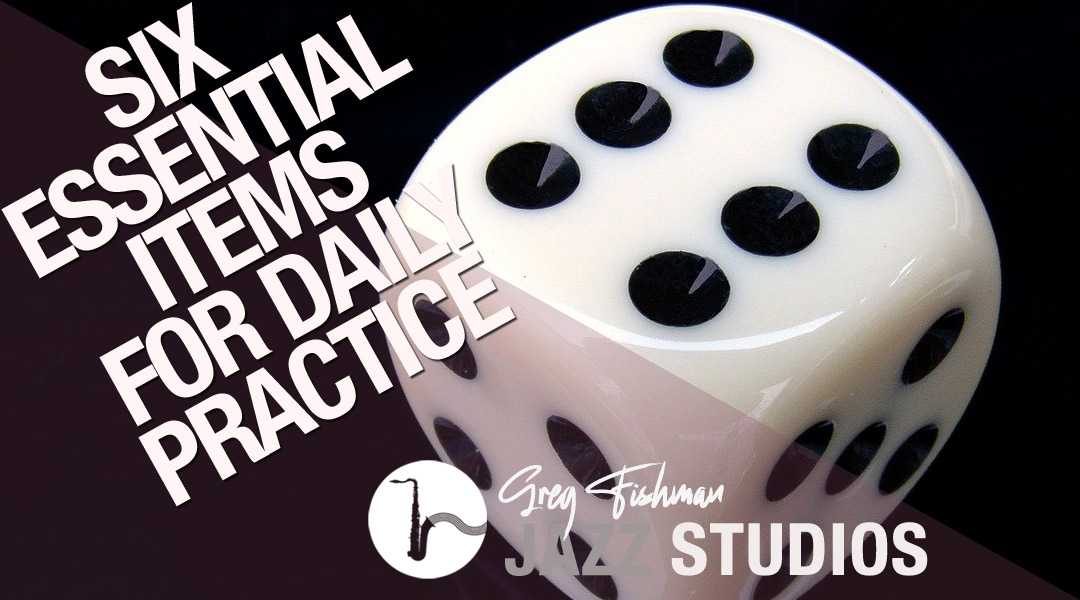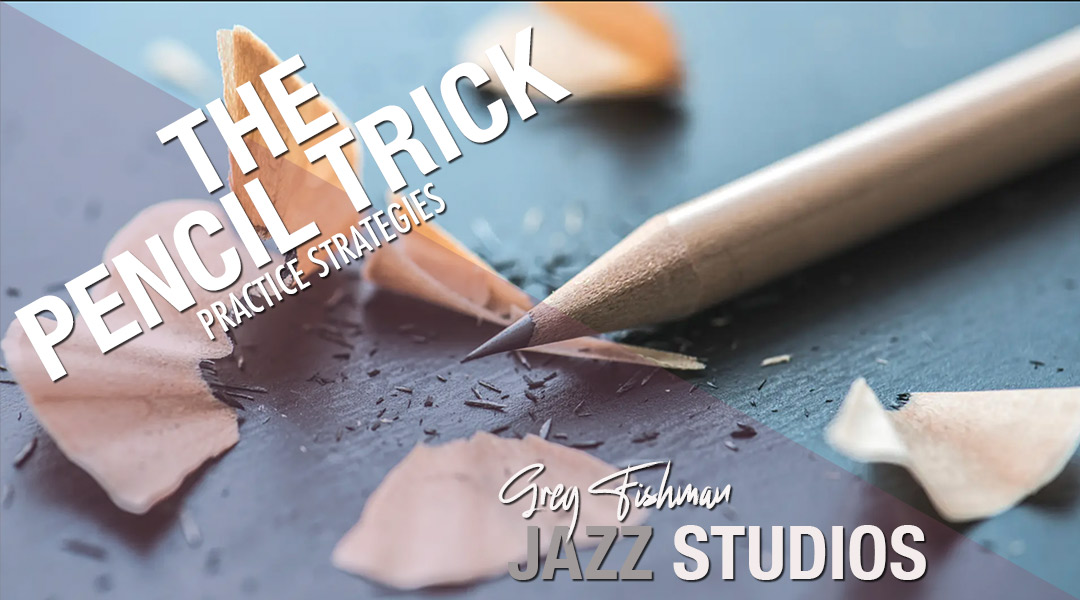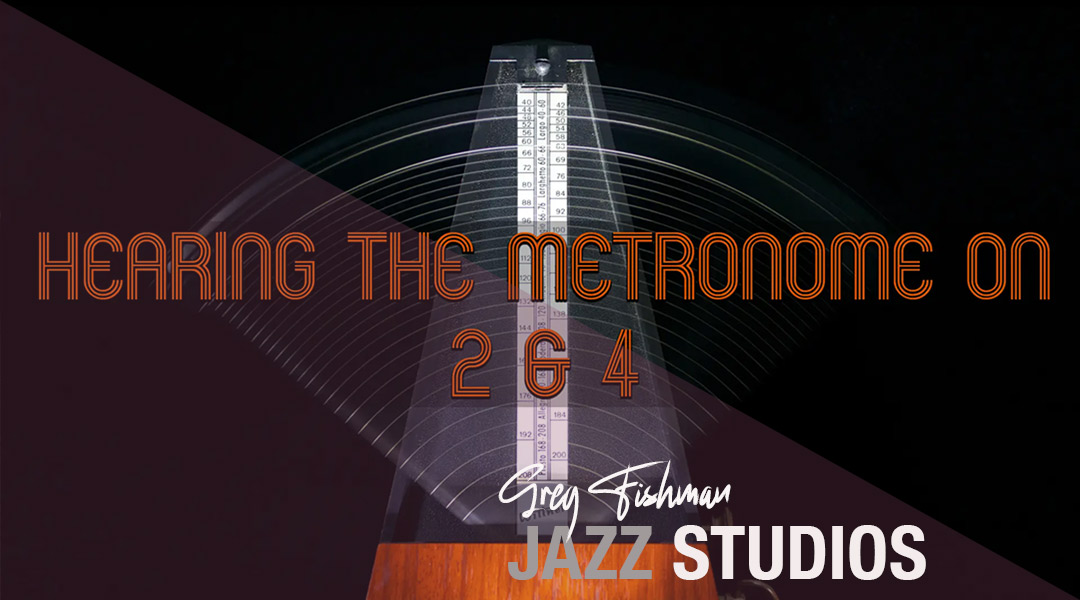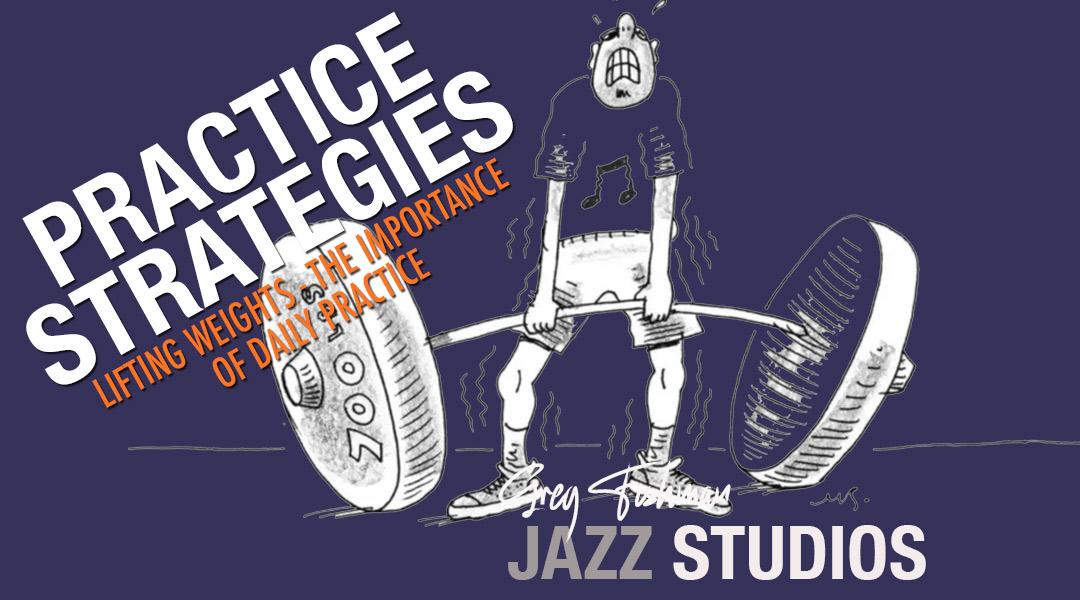The Rotation – Practice Strategy for Improved Musical Memory
The High Tide Approach to Scale Practice
The High Tide Approach to Scale Practice
Creative Scale Practice
Creative Scale Practice
Six Essential Items for Daily Practice
Six Essential Items for Daily Practice
Exploring Hip Lick #37
Exploring Hip Lick #37
Tasting Harmony – Practice Strategies
Tasting Harmony – Practice Strategies
The Pencil Trick
The Pencil Trick
Hearing the Metronome on 2 & 4
Hearing the Metronome on 2 & 4
Interactive Metronome Practice
Interactive Metronome Practice
How to get a full tone on the Palm Keys
How to get a full tone on the Palm Keys
How to Play What You Hear in Your Head
How to Play What You Hear in Your Head
Lifting Weights – The Importance of Daily Practice
The Importance of Daily Practice
The Rotation – Practice Strategy for Improved Musical Memory
The Rotation – Practice Strategy for Improved Musical Memory
The High Tide Approach to Scale Practice
The High Tide Approach to Scale Practice
Creative Scale Practice
Creative Scale Practice
Six Essential Items for Daily Practice
Six Essential Items for Daily Practice
Exploring Hip Lick #37
Exploring Hip Lick #37
Tasting Harmony – Practice Strategies
Tasting Harmony – Practice Strategies
The Pencil Trick
The Pencil Trick
Hearing the Metronome on 2 & 4
Hearing the Metronome on 2 & 4
Interactive Metronome Practice
Interactive Metronome Practice
How to get a full tone on the Palm Keys
How to get a full tone on the Palm Keys
How to Play What You Hear in Your Head
How to Play What You Hear in Your Head
Lifting Weights – The Importance of Daily Practice
The Importance of Daily Practice
Module 50
LESSON 1: (Part 1) Minor Tetrachord over Four Dominant Seventh Chords
Part 1 of 2 Category: Ear Training and also in the Chord and Scale Categories.
A tetrachord is a four note scale. You could look at a major scale as being made up of two tetrachords: CDEF as the first tetrachord and GABC as the second tetrachord.
These examples are major tetrachords. You could think of a Dorian scale to produce two minor tetrachords: CDEbF is the first minor tetrachord and GABbC is the second tetrachord.
In this video lesson, I explore the minor tetrachord over four dominant seventh chords.
This lesson provided an ear-training breakthrough for me when I first discovered this practice approach. The video shows you how to train your ear to recognize the harmonic differences of the notes of the tetrachord when placed over four dominant seventh chords.
It is important to note the the minor tetrachord fits many more than four chords, but for the purpose of this particular lesson, I wanted to narrow the focus for the sake of ear training and explore the sounds of two different minor tetrachords over four dominant chords.
This approach combines many different categories of study; it’s a scale study because of the tetrachord (a four note scale), It’s a chord study, and it’s also an interval study as well as an ear training system. Includes detailed PDF practice notes for Bb, Eb and C instruments.
LESSON 2: (Part 2) Minor Tetrachord over Four Dominant Seventh Chords
Part 2 of the lesson on minor tetrachords. This portion of the lesson focuses on using tritone intervals created by combining notes of two different minor tetrachords.
The notes are then placed over the four dominant seventh chords to produce a strong melodic and harmonic effect over each chord.
LESSON 3: Pinky Control – The Secret to Smooth Technique
In this video lesson, I share a concept that completely transformed my technique on the horn.
In 1995 I was on a four-month gig in Singapore. It was a wonderful gig, playing four hours a night, free all day to practice my horn. I decided to rebuild my technique. I wanted to improve my speed, fluidity and smoothness.
At that time I was transcribing a LOT of Stan Getz. Getz’s technique is so clean and smooth. When I was playing along with his recordings, I noticed something…a lot of his lines involved a lot of pressing of the pinky keys, in both the left and right hand. I noticed that my pinkies
were flying far off of the keys. I also noticed that the G# and D# keys are what I call “reverse action” keys. By reverse action, I mean that when you press the pinky down to activate the G# and D# keys, you’re opening the keys, and when you release the key, you’re actually closing the keys.
This is the reverse of how almost all of the other keys on the horn operate. Think about pressing the F key…You press it to close it and you release it to open it. This is the opposite of the pinky keys. Because of this reverse action, it is always harder to play evenly when the pinkies are involved. This means that in order to play a smooth line of eight notes involving the pinky keys, takes very precise control.
I also learned at that time, that I was applying too much pressure once the key was down. It took a lot of slow practice and patience, but my technique was completely transformed after I started to pay close attention to my pinky technique, in particular. Of course, there are more aspects to clean technique than just the pinkies, but I’ve found that if the pinkies are in good position and played with control, the rest of the hand is also in a comfortable, relaxed position, as well. If you’ve already worked on my “surfer analogy” to improve your technique, this additional lesson on pinky control will give a level of technical poise that would make Stan Getz proud!
Includes PDF lesson notes based on the fingerings for tenor, as demonstrated. Alto players should use the same fingerings as demonstrated in the video (included in the PDF).
LESSON 4: The Rotation – Practice Strategy for Improved Musical Memory
In this video lesson, I share a practice concept that was a total game-changer for my ability to memorize and keep track of lots of different musical ideas while also transposing into different keys.
The rotation will help to improve your musical focus and concentration. I’ve included detailed PDF practice notes for Bb, Eb and C instruments, but I recommend that you try to follow along by ear to really expand your musical memory.
You can use this device on any musical content you like, but for this video lesson, I’m referencing another lesson from the course, “six variations on a descending minor seventh chord.”
This lesson will take your musical focus and memory to a new level!
Module 49
LESSON 1: Creating a melody from Three Voice Leading Lines
In this video lesson, I demonstrate how to construct a melody from three voice leading lines. This is a great way to make your playing sound both melodic and harmonically accurate.
Harmonically, this approach covers you because you’re using voice leading from three locations in each chord, leading to three new locations in the upcoming chord. Melodically, you’re covered because this approach has built-in sequencing when you switch between the three voices.
Includes PDF practice notes for Eb, Bb and C instruments.
LESSON 2: Exploring Hip Lick #3
In this video lesson, I explore Hip Lick #3 from Hip Licks for Saxophone, Volume 1. The lick highlights a iimi7 V7 chord progression, starting on the 9th of the iimi7 chord.
The video explores strategies for hearing the root movement, 7-3 voice leading and hearing how to easily locate the first note of the lick, which is the 9th of the iimi7 chord. For advanced players, I demonstrate some ways of extending the lick into a two measure
phrase. Includes PDF practice notes for Bb, Eb and C instruments.
LESSON 3: The High Tide Approach to Scale Practice
In this video lesson, I share my concept called “High Tide” for scale practice. This approach will improve your technical facility on the saxophone while also improving your musical memory.
This approach adds one new note each time you ascend the scale from the root. If you’ve been playing your scales the same-old-way for many years, this new approach will add extra freshness for your ears and your fingers.
LESSON 4: The Surfer Analogy & Thinking in Reverse
In This video lesson I share two key concepts that will help to give you smooth technique through efficiency of motion, minimizing any wasted finger movement while
playing the saxophone. In the surfer analogy, your fingers are the surfers, the keys are the surfboards and the keys moving up and down on the horn are the waves of water.
The “thinking in reverse” concept is something that i developed in my 30’s when exploring ways to improve my technical accuracy on the horn. I found that instead of thinking about the finger pressing the note being played, my technique improved if I focused on the keys not being pressed. Implementing these two concepts will greatly improve your technique on the saxophone.
LESSON 5: Road Tips – Location of Notes within Dominant 7th Chords
In this lesson, I show you how to think of one note in four different locations within a Dominant 7th chord. For example, C = Root of C7, but C = the 3rd of Ab7, C = the 5th of F7, and C = the 7th of D7. The importance of enharmonic notes is also discussed in the video. The first part of the video is at an easy pace.
At the end of the video I do a “speed round” for advanced players. This is a fun way to review and sharpen up your chord spelling skills.
Module 44
LESSON 1: Six Essential Items for Daily Practice
In this video lesson, I discuss the importance of practicing each item on my practice planner. I developed this approach in my 20’s when I was practicing many hours each day. I experimented with many different approaches to practicing and found that these six items yielded the best results.
Many people get stuck practicing only scales or chords and never seem to get to other items like vocabulary, transcriptions, etudes, and tunes.
Includes PDF practice planner.
LESSON 2: Secret Applications for the Bebop Scale
In this video lesson, I share what I call the “secret” applications for the bebop scale. These are not the types of applications that you learn in school. In both my undergrad and graduate studies, there was no mention of these applications of the scale.
And yet, when I transcribed the masters, I found that they routinely applied the scale in this way when they wanted to get more harmonic flavor from the scale.
If you’ve ever been at a loss for how to use the bebop scale over a minor ii / V situation, this video will show you how to apply the scale like a seasoned professional.
Includes detailed PDF practice notes for Bb, Eb and C instruments.
LESSON 3: Creative Scale Practice
In this video lesson, I share a story about one of my Skype students who was very bored with his scale practice. He was in a rut, always playing his scales like a technical exercise, rather than finding the music hidden within the scales.
I showed him these creative practice strategies that I use in my own practice and he was instantly playing with more energy and creativity while also improving his musical memory and his instrumental technique.
Includes detailed PDF practice notes for Bb, Eb and C instruments.
LESSON 4: C.E.S.H. – What it is and How to Use it.
In this video lesson, I explore and explain C.E.S.H. The term was coined by one of my former teachers, the great Jerry Coker. It stands for “Contrapuntal Elaboration of Static Harmony.” Basically, it means that you apply voice leading to a chord within itself by moving the sevenths (and sometimes the fifths).
This is a common harmonic device used by all pro players. You’ll recognize it as soon as you hear it. I explain the device and break it down in a way that makes it easy for all levels of players to immediately use this in their solos. Includes detailed PDF practice notes for Bb, Eb and C instruments.
LESSON 4: Thumb Position for the Octave Key
In this video lesson, I discuss and demonstrate the importance of good thumb position on the saxophone. This topic is often overlooked. Over the years, I’ve taught many students who needed to correct bad habits with their thumb position. In some cases, students were experiencing pain from using the wrong position or from using too much pressure.
The left hand cannot operate with efficiency without an excellent thumb position, combined with a light touch. If you’ve ever had issues with left-hand technique problems or pain in your left hand or arm due to the octave key, this video will address all of those issues and provide a clear strategy to fix the problem.
Module 34
LESSON 1: Four Directions – Thinking Locally and Globally
I often mention practicing in four directions for gaining mastery over your scales, chords and intervals. In this video lesson, I explore and explain the four directions. I describe the difference between thinking “locally” and “globally” when playing a sequential pattern.
LESSON 2: Finding the hidden Diminished and Augmented Chords in the Chromatic Scale
In this video lesson, I show you how to use the chromatic scale to diminished chords and augmented chords. Although I demonstrate these same chords in different video lessons (playing all of them on piano), this is an alternative approach, designed to help players that find it a real challenge learning the traditional way.
LESSON 3: Exploring Hip Lick #37
In this video lesson, I work with lick #37 from the book “Hip Licks for Saxophone Volume 1.” This is a two-measure C7 lick that uses part of the bebop scale, contrary motion, sequence and a diatonic enclosure.
In this video lesson, I share my technique for this popular special effect tonguing used by Getz, Bird, Pres and many of the top players from the Swing/Bop era. This one is intentionally an “all-ear” lesson, so there are no practice notes on this one.
LESSON 5: Listening Recommendation: Clifford Brown • Max Roach
This amazing 1958 album has so many classics…Daahoud, Joy Spring, Jordu, Parisian Thoroughfare…all on the same album. The beauty and symmetry of Clifford’s playing throughout this album is breathtaking.
Module 13
In this video lesson, I take you though my system for practicing the Dorian scale. You may already know the scale, having learned it the traditional way, as the second mode of a major scale, going from the second note of the major scale to the ninth note. While that method does give you the right notes for Dorian, it doesn’t really train the ear to hear the upper extensions of the minor chord contained within the scale. With my system, your ear will be trained to hear the difference between the sound of the 9th, 11th and 13th. This is a really fun system, and in addition to great ear training, it’s also good workout for your technique. If you already know the Dorian scale, you should watch this video to experience the sound of the scale in a new way. If you’ve never learned the Dorain scale, this is the best way to get started! INTERMEDIATE LEVEL.
In my 20’s, I was transcribing many hours each day. I got tired of putting down the pencil and picking it up again to write a just few more notes. For the sake of efficiency, I just started to hold on to the pencil, even when I was playing the horn. To my surprise, it really helped my technique. Holding the pencil dramatically improved my hand position on the horn. In this lesson, I’ll take you through the process of practicing the “pencil trick,” and also share a few other crazy strategies that I’ve used to getting my fingers in a better position on the horn. INTERMEDIATE LEVEL.
In this music theory video, I’ll take you through from the very basic application to of the tritone sub, all the way through the relationship between altered notes on the native V7 chord and extensions of the tritone substitute. PDF extras include scans of the actual sheets I created during the filming of the video lesson. INTERMEDIATE & ADVANCED LEVEL
Many group members have asked me to create a video in which I demonstrate some of my practice techniques for working with the book, Tasting Harmony. In this video, I explain the concept of the book and demonstrate many different ways of working with the play-along tracks. The extras with this video include several pages from the book, some of the exercises from the video, plus the mp3 tracks. ALL LEVELS.
Greg shows how to keep your mind focused and sharp even when you’re away from the horn. This music theory game involves thinking of the note “E” as different degrees of major scales.
Module 23
This video lesson starts with a demonstration of the lick played in several keys, followed by a step-by-step approach showing you how to create the lick.
In this video lesson, I explore the traditional way the modes are taught and then demonstrate my system of playing all of the modes “sandwiched” between a low and high C.
In this video lesson, I share an approach to working with the metronome in which the metronome is an active, rhythmic part of the solo. I have the metronome clicking on 2 & 4, and I make up a solo based on the chords of “Take the A Train.”
In this video lesson, I show you my technique for hearing the metronome on beats two and four.
In this video lesson, I discuss one of my favorite Dexter Gordon albums.
Module 25
In this video lesson, I’ll show you how to work with Hip Lick #8 from my book, Hip Licks for Saxophone, Volume 1.
In this video lesson, I demonstrate how I like to use the 4th of the scale or chord to create tension and then resolve the note to the 3rd or 5th. Many aspiring players have been told that the 4th is an “avoid note.” This is very bad advice because all players need to know how to deal with this note when it comes up. You can’t just ignore it or avoid it.
Many group members have written to me, asking for a video lesson teaching them how to get a big, powerful sound on their palm keys. In this video, I share my unique approach to getting a full, big tone on the palm keys.
If you’ve ever had trouble getting a nice sound on your palm keys, this video will be transformative. Includes PDF lesson notes. INTERMEDIATE LEVEL
In this video lesson, I share what I call the “Coltrane Triplets.” This is a way of practicing your chord arpeggios with triplets.
CLICK HERE to download PDF lesson materials
In this video, I discuss one of my all-time favorite albums, Dave Brubeck’s monumental 1959 recording, “Time Out,” featuring the great Paul Desmond on alto.
Module 28
In this video lesson, I share some of my techniques for getting the sounds in your head to come out on your horn.
In this video lesson, we’ll explore one of my favorite harmonic settings a minor second interval, acting as the 3rd / 9th / 3rd of a minor seventh chord. This has a very Getzian kind of sound…smooth and melodic. Includes page 22 from “Intervals in Action,” plus detailed PDF practice guide for C, Bb and Eb instruments. INTERMEDIATE LEVEL
In this video lesson, I explore what I call the “Phil Woods” turnaround lick. It uses two voice-leading notes to create a beautifully balanced, melodic line of eighth-notes.
Part of the bebop tradition involves the usage of both upper extensions and implied harmony. The mixing of the minor triad with a diminished seventh chord adds a strong harmonic boost to any minor passage.
In this video, I discuss one of my all-time favorite albums, Charlie Parker’s masterpiece album, “Charlie Parker with Strings.” The album features popular standards from the Great American Songbook, arranged for the strings-plus-rhythm section. Parker at his most eloquent. One of my all-time favorites.
Module 27
In this video lesson, you’ll observe me working with my Skype student Ritchie Graham (in Scotland). Over the years, many students have struggled with this double-time passage that I composed for my etude “Ravenswood Avenue.”
LESSON 2: Confirmation Changes / Hyde Park Blvd w/Aebersold
In this video lesson, I’ll show you how to nail the changes on Confirmation through good voice-leading, demonstrated in my contrafact for Confirmation, titled “Hyde Park Boulevard.”
In this video, I read the first chapter of my book, “The Lobster Theory.” This chapter is called “Lifting Weights,” and it’s about the importance of practicing each day.
In this video lesson, I’ll show you a very cool Sonny Stitt triplet pattern that works great over a ii mi7 / V7 progression.
In this video, I discuss one of my all-time favorite albums, guitarist Wes Montgomery’s 1966 Verve album, “Tequila.”












